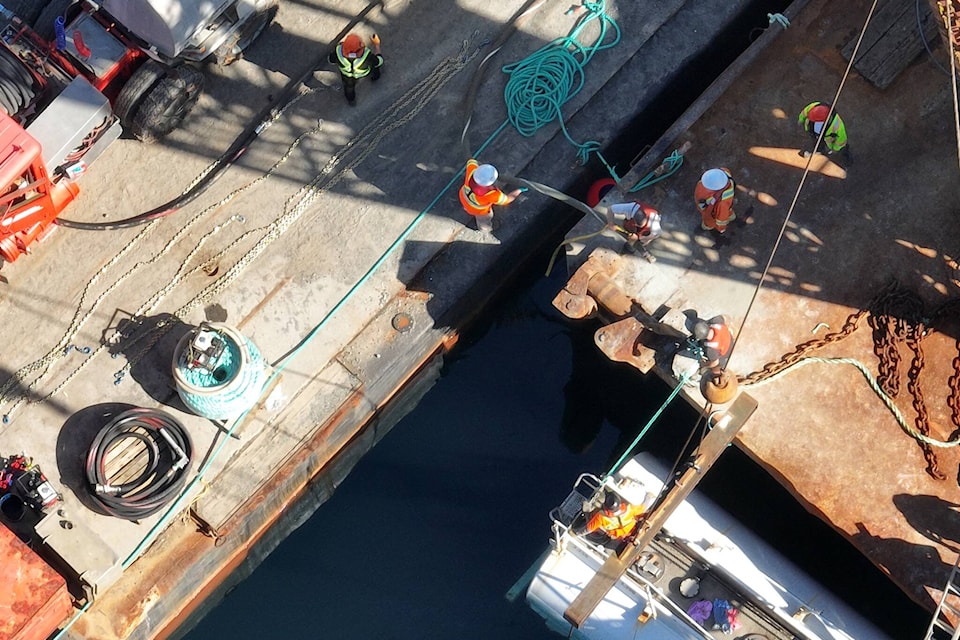First Nations Guardians are playing a key role in the response to a fuel truck spill just north of Campbell River.
On April 20, a fuel tanker truck loaded with 17,000 litres of diesel fuel rolled off of a barge and sank in 35 metres of water in Chancellor Channel, just off Hardwicke Island. The Ha-ma-yas Guardians, who have been practicing responses to marine disasters for three years, responded quickly.
“I’m immensely proud of all of our Guardians,” says K’ómoks First Nation Chief Ken Price. “Not only K’ómoks but Guardians of the Wei Wai Kum, We Wai Kai and Tlowitsis Nations all worked together rapidly and effectively to assist in a situation that needed fast, experienced action to try and minimize environmental damage to our territories.”
Incident and Clean Up
The barge was en-route from Menzies Bay, just north of Campbell River to supply fuel to a logging operation on Hardwicke Island. During high winds, the tanker fell from the barge and sank. Marine Link Transportation was operating the barge, and informed the Coast Guard immediately. They also contacted the marine response corporation. The area is a sensitive environmental area located on the territories of the We Wai Kum, We Wai Kai and K’ómoks First Nations.
“We were ready,” says Wei Wai Kum representative Tony Roberts Jr. “Along with the other Nations we immediately stepped into the Unified Command centre that was established, along with the Coast Guard, Marine Link Transportation, who were operating the barge, and the provincial Ministry of Environment and Climate Change Strategy.”
The following day responders arrived on scene. The three agencies deployed an underwater remote vehicle to locate the truck. At the same time an incident command team was set up to manage the response. That was supported by Nanwakolas Marine Planner Barb Dinning, who took on a coordination role in the Nations’ involvement both on-water and in Incident Command for this first real-life implementation of the Nations’ response strategies.
“Unified Command met multiple times a day to discuss the priorities for retrieving the truck as soon as safe and practical, with the least possible release of diesel fuel into the marine environment, and to implement strategies for the protection of environmentally and culturally sensitive areas,” said Chief Price. “All three First Nations had deployed our Guardians immediately to work with on-water responders on site, to help with the operations and to ensure the First Nations leadership were fully informed about the status of the operations so we could make our decisions about the appropriate next steps to take.”
The seabed was continually surveyed near the truck by divers. The divers also patched areas that were leaking while the equipment to lift the truck was prepared. Though the leaks appeared to be intermittent, a release Ha-ma-yas says the amount leaked is unknown. After the truck was lifted on April 28 and the remaining fuel was removed from the truck, it was estimated that potentially as much as 15 per cent of the fuel had leaked into the environment, or up to 2,500 litres.
The local knowledge and expertise of the Guardians of the Wei Wai Kum, We Wai Kai, Tlowitsis and K’ómoks First Nations was indispensable to the operation. Both Marine Link and the Coast Guard members of Unified Command acknowledged the vital role that the First Nations had played
“They told us openly they could not have done this without us,” says We Wai Kai Guardian Manager Shane Pollard. “It was good to hear that appreciation for our work, and acknowledgement of how important our participation in response and recovery activities are.”
Next Steps
Now that the initial pollution response and recovery is complete, Shoreline Cleanup Assessment Techniques (SCAT) activities are the next immediate step for Incident Command to consider, particularly in light of the amount of fuel that may have leaked into the water. On May 3 Guardians returned to the site to check on environmentally-sensitive coastlines near the incident. These include cultural sites, salmon-bearing streams and eelgrass beds.
The incident also is the first “real life” test of the partnership between the coast guard and the Guardians. The groups will be using the incident to look at what worked well and what could be improved.
“These types of accidents aren’t uncommon,” said Wei Wai Kum elected Chief Councillor Christopher Roberts. “We see a lot of marine-related pollution incidents and marine emergencies in Wei Wai Kum territory. Marine activity is only going to increase, I think. That’s why we need continued and sustained investment from partners like the Coast Guard, and investment in our First Nations Guardians to do their work, so that we can all get better and better at being able to protect our important marine and cultural areas together. What happened here is a clear demonstration of that.”
Nanwakolas Council President Dallas Smith applauded the work of the First Nations and their Guardians in the process. “We have been saying for a long time that the Guardians are the ones with the most intimate knowledge of our territories, who understand local tides, currents, and marine conditions so well because they are out there year-round, and they really have the highest stakes in protecting the environment and important cultural sites in our territories.”
RELATED:
marc.kitteringham@campbellrivermirror.com
Like us on and follow us on




